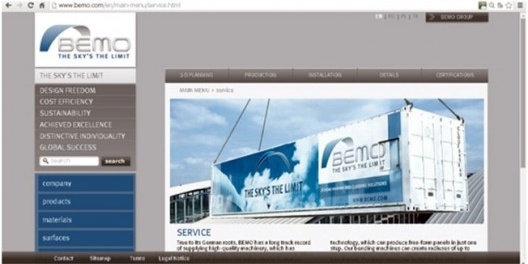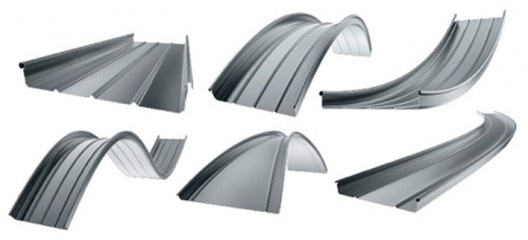
A máquina MONRO da BEMO, instalada em um container para poder ser transportada para qualquer local para produzir painéis de dupla curvatura diretamente no conteiro de obras
Imagem divulgação [Website Bemo]
Gabriela Celani: What are the differences between Bemo in Germay and Bemo do Brasil? What is their major fields of application?
Peter Mehrtens: Bemo is an alliance. Bemo do Brasil is a Brazilian-owned and operated company, whereas Bemo Project Engineering and Bemo Systems are separate companies which are owned and operated form Germany. In terms of what we do we produce similar things, however Bemo do Brasil is a construction company that fabricates and installs [the roofing], while Bemo Systems and Bemo Project Engineering are basically an engineering office within a holding that also has production facilities. This means we design building envelopes as an assembly kit and fabricate the building kit, however we don’t install it, we don’t have installation teams that go to site. But the major difference is probably the technology. Bemo Germany operates a free-form panel production facility of Bemo free-standing seam panels. This is a technology that is digitally controlled and can produce mass-customized panels in a digital industrial approach. For complex projects Bemo do Brasil collaborates with Bemo Project Engineering to design and create these buildings.
GC: Some of the works that you showed us had this special quality of really good architecture. They used this very industrial material but they had a very sophisticated character. I don’t see this type of application in Brazil. I don’t know if it’s because we don’t have the double curvature machine of it it’s because people don’t like it here. Perhaps people here think it looks too industrial. One exception was the Arena das Dunas in Natal. Can you describe what was the role of the two companies in that building?

A máquina MONRO da BEMO, instalada em um container para poder ser transportada para qualquer local para produzir painéis de dupla curvatura diretamente no conteiro de obras
Imagem divulgação [Website Bemo]
PM: This was a Fifa World Cup stadium in Brazil, in which Bemo do Brazil had the overall contract to assemble the envelope on top of a space-frame structure that had been provided by a steel contractor working for the general contractor. The initial design had been made by Populous. However, the conceptual design was given but the execution was left to the general contractor, who in turn passed the task of creating the surfaces and the panel layouts over to Bemo. So Bemo Project Engineering in Germany took care of the parametric modeling and the generative design of the panel layouts, and the shape of the stadium has regions that are formed with double curvature with high curvature, which means that you must have mass-customized panels to clad this surface, and it had regions that had predominantly single curvature, which could be covered with conventional panels. To keep the cost efficient we have rationalized the panel layout such that only a certain percentage of the building envelope required the free-form paneling technology, which were then fabricated in Germany and shipped to the site in Brazil. Bemo do Brasil produced the conventional panels here in Brasil. In order to ensure that the panels produced in Germany and the panels produced in Brazil had the exact same finish, coils of the raw material with the final color coating were shipped from Brazil to Germany ahead of schedule so that we could produce the panels in Germany and ship them back and they would have the same finish. Alternatively an option would have been to transport the machine over. However, due to other projects that had to be produced almost simulatenously and the fact that only a certain percentage of the building envelope required free-form panels, it was more efficient, in that case, to ship the panels, and not the machine. Both, however, is possible.
GC: And the panels were shipped in containers, right? How long were those parts?
PM: Yes! They were 11.5m I think, so they fit in a 12m-long container.



